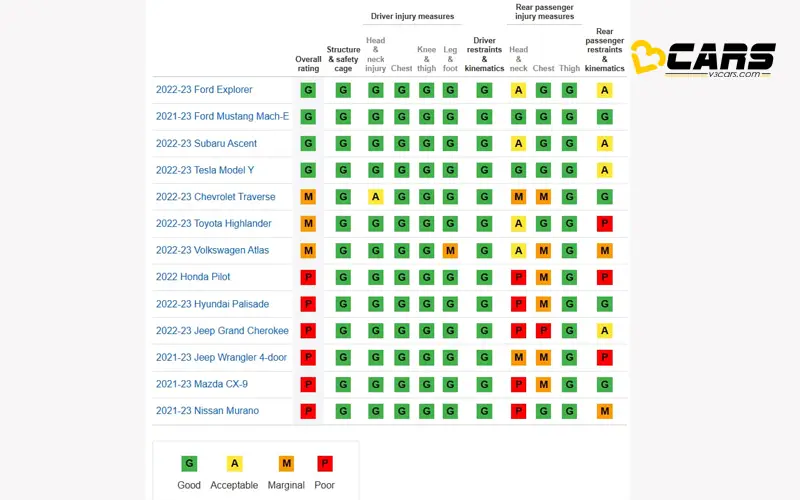IIHS: Your Car's Rear Seats Aren’t As Safe As You Think | V3Cars
The Insurance Institute for Highway Safety (IIHS) of the United States recently conducted a front moderate overlap crash test of 13 SUVs with rear seat dummies. Of the 13 cars, only 4 (Ford Mustang Mach-E, Tesla Model Y, Ford Explorer and Subaru Ascent) managed to walk away with a ‘Good’ rating. 3 cars got a ‘moderate’ rating while the rest received a ‘poor’ rating. This was mainly because of poor rear occupant safety ratings. The front seat occupants remained fairly safe pretty much across the board. Read on to know more about the recent findings.

Also Read: Top 7 Safest GNCAP Tested Petrol Cars In India
Note: Check your Car EMI with our - Car Loan EMI Calculator
The IIHS updated its longstanding moderate overlap front crash test to include a rear passenger dummy positioned behind the driver to focus on rear passenger safety. The new test measures the injuries most commonly seen in rear-seat occupants, including head, neck, chest, abdomen and thigh injuries.
Although vehicles from model year 2007 onward have a higher risk of fatal injury for rear-seat passengers than front-seat passengers, the new test shows that restraint technologies have only improved for front-seat passengers. The updated test incorporates a Hybrid III dummy representing a small woman or 12-year-old child positioned in the second row behind the driver. To earn a good rating, measurements recorded by sensors in the second-row dummy must not exceed limits indicating an excessive risk of injury.
Out of the 13 midsize SUVs tested, only the Ford Explorer, Ford Mustang Mach-E, Subaru Ascent and Tesla Model Y earned a good rating for rear passenger protection. Three other SUVs, the Chevrolet Traverse, Toyota Highlander and Volkswagen Atlas, earned a marginal rating, while the Honda Pilot, Hyundai Palisade, Jeep Grand Cherokee, Jeep Wrangler 4-door, Mazda CX-9 and Nissan Murano were rated poor.
According to IIHS Senior Research Engineer Marcy Edwards, “Zeroing in on weaknesses in rear seat safety is an opportunity to make big gains in a short time, since solutions that are already proven to work in the front can successfully be adapted for the rear.” The 4 good-rated vehicles provide superior protection for rear passengers, with the seat belt remaining properly positioned on the pelvis and the side curtain airbag performing correctly. However, measurements taken from the rear dummy indicated a slight risk of head or neck injuries for the Ascent, Explorer and Model Y, as the rear dummy's head approached the front seatback, increasing the risk of head injuries.
For the marginal-rated Atlas and Highlander, measurements indicated a similar slight risk of head or neck injuries for the rear passenger, while the Traverse showed a more significant risk of such injuries. In the poorly-rated vehicles, measurements taken from the rear dummy indicated a high risk of head or neck injuries to the rear passenger in the CX-9, Grand Cherokee, Murano, Palisade and Pilot and a significant risk of head or neck injuries in the Wrangler.

In conclusion, the IIHS crash test ratings highlight that the rear seats of most midsize SUVs aren't as safe as you might think. Rear passengers are at a higher risk of fatal injury than front passengers and the updated test reveals that only a handful of midsize SUVs extend the same level of safety to the back seat as the front.
If you are buying a very safe, 5-star rated car and then not buckling up in the rear seat, then you’re nowhere near as safe as you think. In fact, this recent IIHS finding, tells us that even if you’re wearing a seat belt, you’re still at a much higher risk of injury than front seat occupants.
Note: Check your car’s fuel cost with Fuel Cost Calculator in India


0 Comments